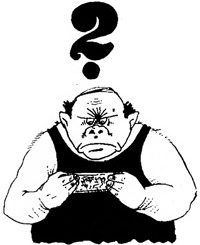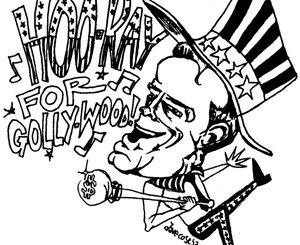 Generation X or Generation PG
Generation X or Generation PG
by Kerry Joyce
“Ya say you wanna revo-lu-shah-uh-un, Well-hell you know-oh
We’d all love to see the plan.”
That way, we of the baby boom generation can force feed it through an Olly North brand paper shredder, and recycle it into an all-natural mirror image of ourselves, thank you very much.
Youth usually has more to offer the world that it can successfully bring to market. In areas where achievement is most measurable: Sports, science, and mathematics, the superstar over 40 or even much over 35 is a rarity, and the world has given youth the honor they deserve in these fields. However, in those areas where quality cannot be quantified, and is therefore subject to opinion, older people rely upon their superior wealth, position, savvy, and reputations to compete successfully against those whose youthful strength puts at the peak of their artistic powers.
Celebrity status having the value that it does, a new record by Paul McCartney or a novel by Norman Mailer, generates enormous interest by the media, despite the fact that their latest efforts are mediocre and the coverage they receive is necessarily at the expense of some younger, and now more capable artists.
In the old days, a large percentage of artists could be depended upon to die of some dreadful infectious disease (Keats at 25 and Mozart at 35) or from their own excesses (Edgar Allen Poe, Oscar Wilde, and Brian Jones) well before their brain matter degenerated to the point where their faculties were merely at the level of everyday mortals. With the advent of penicillin, plastic surgery, and those muse-killing Betty Ford Clinics, however, artists are now living long past the point where their efforts are of any use to anyone, except various and sundry ex-wives, investment bankers, attorneys, lifeless nostalgia freaks, and whatever photographer can goad one of them into a multi-million dollar blow to the head.
Other medical advances, such as coronary bypass surgery, needlessly prolong the lives, and thus the careers of older artists. At one time, it was believed that the heart was the source of emotion and artistic inspiration. But it is now known that the heart is simply a pump, and that these bypass operations do nothing to alleviate the inadequate circulation of blood flow to the older artist’s brain, which is the true engine of artistic expression, or lack thereof.
AIDS has failed to kill off nearly as many aging hipsters as was initially hoped. It had devastated only one group of artists (male homosexuals) who as a stigmatized minority, have been less successful in exploiting their professional reputations with shoddy work, nearly to the extent of their heterosexual counterparts. Even when AIDS is transmitted through heterosexual contact, it generally afflicts the young, and not the intellectually-challenged older artist.
Television has exacerbated the problem of evaluating art, independently of the artist. Americans only reluctantly show interest is the work of an unknown. An unknown being one whose face has not appeared at least a dozen times on the living room television, courtesy of some malevolent network satellite.
The existence of superstars is good for business, so television aids and abets in the creation of personality cults around big name performers. Broadcasters love superlatives: “It was number one in 1958, and again in 1976. It is the only song to hit the top ten three times for four different artist. You hated it then, you loathe it now, and so do we. But it’s so big, we can’t resist. And neither can you. Here it is: “Blah Blah To You Baby And Your Blah Baby Blah”.
The routine oppression of youthful sensibility has made the “Coming of Age” genre a staple of literature. For millennia, youth endured their subjugated status, the more troublesome were executed, persecuted, driven to poverty and madness, while others vowed to hold their tongue, until their turn at last came, only to wake up one day, and discover that they had become the very people their conscience warned them against.
The advantages of noble birth gave some young people a chance, and early death provided more opportunities than today. Life expectancy in the United States was about 40 years in 1900. Despite huge increases in life expectancy in the first half of the 20th century, the balance of power seemed to shift, in favor of the younger generation during an era commonly known as The Sixties. The Sixties actually began in 1964, when the Beatles first performed on The Ed Sullivan Show, the curtain fell on the period in 1974, with the end of the War in Vietnam, and of Richard Nixon’s presidency.
Unified as never before, by radio and an unpopular war, and having the advantage of looking more attractive on the screen of the great TV god, the young people of The Sixties had the money, sophistication, education, and the sheer numbers to challenge the cultural primacy of their parent’s generation like no generation before, or certainly since.
The influence of today’s generation of young people is minuscule compared with that of The Sixties youth in the fields of art, music, politics, literature, journalism, and broadcasting. The role of today’s youth compares unfavorably with other generations as well. Our system of government, which is emulated throughout the world, was primarily the work of four men whose lasting intellectual achievements were made while they were under the age of 35: Thomas Jefferson, John Adams, Alexander Hamilton, and James Madison.
Not only in mathematics and science, but also in the fields of literature, art, theology, and philosophy, our world has been shaped by those whose greatest intellectual achievements came about when they were younger than the average age that today’s scholar receives his Phd. (i.e. License To Think).
There are two possible explanations for this generation of silent or silenced youth: Either the current crop of young people had far less to contribute than did previous generations, or the youth of today are being somehow deprived of their rightful place in the cultural life of the country. Perhaps the social changes of the past two decades have been less profound and it is role of “Generation X” to be “Generation PG,” a caretaker generation that simply preserves the traditions of the past. Maybe a culture becomes exhausted and can sustain only a single generation of social upheaval per century.
Many of today’s youth seem content with synthetically re-creating The Sixties rather than creating The Nineties, and even those strong willed individuals who do not wish to “make it new” but want to smash “it” into little pieces and make it over find much in The Sixties ethos worthy of at least some imitation.
If Generation X is to rebel, it is the baby boomers they will have to rebel against. Is it justifiable to rebel against the architects of a revolution you admire, beyond a selfish will to power? (Revolution For The Hell Of It)
Probably not. But if the urge to rebel is commonly felt, perhaps there is something wrong.
For starters, crediting the baby boomers with the cultural pyrotechnics of The Sixties is mythology, not history. Quick. Write a list of ten individuals you associate with The Sixties. Bob Dylan? Not a boomer. Tom Hayden? Not a boomer. Martin Luther King, Jr.? Not a boomer. The Beatles? Nope. Elvis? Uh uh. Abby Hoffman? Not him either. Hillary Rodham Clinton? Oh yeah, she’s a baby boomer that was prominent during The Sixties. She was president of College Republicans at Wellesley.
Like many members of Generation X, the Baby Boomers were the consumers, not the producers of Sixties culture. The creators of The Sixties shock waves were members of a tiny generation born just before and during World War II. Older than the boomers, but younger than the boomers’ parents. They were spoiled by their mums, and resentful of the hairy faced fellow named Daddy who ruined everything by surviving the war: An ideal breeding ground for the development of an artistic sensibility.
Are you mad yet? Outraged? Pissed Off? Good.
You say you want a revolution? Well, you know, revolutions generally cause more problems than they solve. (See France 1789. Russia 1918.) And as heavyweight champion Muhammed Ali said, when asked about the possibilities of a black revolution in America: “How we gonna have a revolution, when they [the whites] got all the guns?”
What is possible, and often healthy, is not a revolution, but a separatist movement, like the so called American Revolution, which was actually for independence. And like The Sixties youth culture was in the beginning. But not like the cultural isolationist movement which burned to the ground in Waco, Texas earlier this year.
The Sixties began not as a “counter culture,” as it was later called, but as a parallel interconnected universe, a subculture co-existing, and cross-pollinating with mainstream America. When Abby Hoffman testified at his trial for inciting a riot at the 1968 Democratic Convention in Chicago, he called American Youth Culture “Woodstock Nation” and compared The Sixties youth culture with the Nomadic American Indians, to illustrate the point that nations are not about land, but consist of people who share a set of ideals and a sense of togetherness.
The name seems corny now, but it was a brilliant analogy. The real tragedy was that Hoffman himself was one of the people that killed “Woodstock Nation.” Hoffman and his friends tried in vain to transform a subculture into a potent political movement that would subordinate mainstream culture of the older generation. And tried to gain power through the use and manipulation of the television and daily newspaper outlets controlled by the very interests they said they were against.
Would Bohemia reign supreme? No. The older, larger, and wealthier American mainstream culture responded to this political threat in a predictable way. They imprisoned a few, hired a few, audited a few, slandered a few, bribed a few, and drove a few hundred thousand over the edge (including Abby Hoffman, eventually). They lowered the drinking age (for a while), and the voting age, ended the draft, and the war. They made school easier, movies sleazier, crucified Nixon, and let Henry Fonda’s kid do a movie about the hippie lifestyle. They de-ghettoized youth culture and turned it into a McDonald’s Happy Meal with side burns.
Rock musicians, the high priests of The Sixties subculture, mouthed the appropriate platitudes, but often grumbled about the politicization. Before he was himself caught up in the political side of The Sixties, John Lennon wrote the anti-revolutionary anthem, “Revolution.” The political radicals gratefully misunderstood.
At Woodstock, when Abby Hoffman tried cutting into The Who’s playing time with a political speech, Peter Townsend hurled him bodily offstage. “Meet the new boss, same as the old boss” The Who sang skeptically back in 1971 in a song called “Won’t Get Fooled Again.”
Music (Rock ‘n’ Roll) was the heart and soul of The Sixties, radio broadcasting was the bones and muscle. This cultural movement relying on a single informational infrastructure (medium) of radio, and limited almost exclusively to a single form of artistic expression, music.
It was inevitable that some of the musically untalented would want to get in on the action. Television was more powerful than radio, and a radical yelling “power to the people” to an energized crowd was better television than Elvis gyrating his hips while lip syncing “Blue Suede Shoes.” Thus a cultural movement was swept away by a political one, which itself was swept away with a few concessions, political payoffs, and hollow symbolic gestures.
If the hallmark of youth power is a willingness to throw caution to the wind, and an idealism that flouts the pursuit of the almighty buck, then radio, which has now matured into a big business and is an entrenched bastion of Boomer nostalgia, cannot serve as the unifying medium for Generation X.
Rock ‘n’ Roll can be great, but not revolutionary forever. Everything stabilizes over time; then dies, as the intriguers and careerists move in for what they can take, instead of what they can give, engorging themselves on the legacy, and chasing off any innovators.
It is no coincidence the latest music “super group” came of age in Ireland, a remote outpost in Rock ‘n’ Roll’s far flung empire, safely beyond the pale of the corporate music industry’s so-called help.
For delivering today’s youth from Boomer bondage, where a contemporary brand of rugged individualism qualifies one for little more than a job delivering for Dominoes, “desk top publishing” shows some promise. No longer just a marketing slogan, but a reality with the potential power to energize a new youth culture. This emerging press can spread the word about talented musicians ignored by the big radio stations, and provide an opportunity for new writers and visual artists to showcase their work.
Generation X cannot look to the Baby Boomers for their break. They must make their own. Boomer nostalgia is merely a mildly pleasant manifestation of their inner decay. If the next Bob Dylan plays to an approving jam-packed audience in a Seattle night club, and the boomers refuse to listen, is there a sound?



